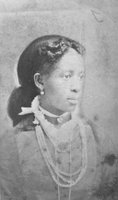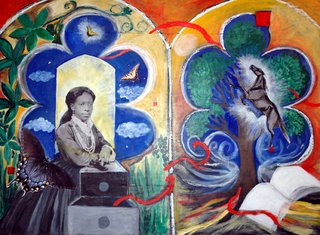
February 5: Full of animation and spirit. I sang and played [piano] at daylight. After Breakfast I found Von saddled and very tastefully arrayed in red ribbon. The weather being pleasant, I hastened to Hurricane. On returning my horse ran off with me. The saddle turned around and I fell almost senseless. Great excitement prevailed. I was brought home in the buggy. My arm was most injured. I only cried because I had to give up today.
Departing Reality, Entering the Imaginal Space
It is upon this entry from MV's diary that we exit reality and enter into the realm of imaginal space. The term "imaginal space" is loosely based on the work of mythologist, Maggie McClary http://www.mythandculture.com/weblog/2005/10/cultural-mythology-methodology.html. McClary uses mythology as a critical thinking tool to examine culture and prejudice. She defines the study of mythology as "the imaginative study of logic, the hidden mythos in the logos." She writes:
To uncover the mythos in the logos requires one to seek out the stories and myths that lie beneath logical structures, scientific theories, hidden assumptions and implicit biases. What lurks beneath an idea, theory, or bias can bring one into an imaginal space in which the logics are the surface of the story but never the entire story itself. In that imaginal space, I move beneath the surface of a predominate idea (i.e. fatness is bad) in order to find the mythos that reveals the hidden ideas and archetypal structures.
While McClary uses Greek mythology in her literal examinations, I refer to another narrative form, the fairy tale, because of its folkloric nature. According to Catherine Orenstein, "fairy tales are told as flights of fancy. They occur outside of history, in a unquantifiably distant past." (Catherine Orenstein, Little Red Riding Hood Uncloaked: Sex, Morality and the Evolution of a Fairy Tale, p. 9)
For me, the fairy tale operates as a kind of meta-myth that crosses cultures because of its symbolism. While the majority population may not know The Illiad they certainly know the story of Little Red Riding Hood and The Three Bears. In my new work the symbols and images that are familiar to us in fairy tales are crossed with stereotypical images (which have become archtypal in American culture). African symbols and representations provide another layer. MV's story is transformed from her journalistic endeavor into an adventure that uses the hero myth as its structure. In particular, I use L. Frank Baum's nineteenth century childrens book (and later the movie), The Wizard of Oz because it is one of my favorite stories and one with which we are all familiar.
In the Wizard of Oz, Dorothy is on a quest to find home--a place of solace, a sanctuary. MV's world is situated in a kind of "slave utopia" the result of the ideals of Scottish social reformer, Robert Owen, and MV's former owner, Joseph Davis. But something is wrong in paradise. While MV may have been afforded opportunities that other slaves could never have imagined, she is still bombarded with nineteenth literature and photographs that disrupt her utopian world. This is where we depart reality and enter into
imaginal space so that MV's diary now reads:
In the Wizard of Oz, Dorothy is on a quest to find home--a place of solace, a sanctuary. MV's world is situated in a kind of "slave utopia" the result of the ideals of Scottish social reformer, Robert Owen, and MV's former owner, Joseph Davis. But something is wrong in paradise. While MV may have been afforded opportunities that other slaves could never have imagined, she is still bombarded with nineteenth literature and photographs that disrupt her utopian world. This is where we depart reality and enter into
imaginal space so that MV's diary now reads:
 February 5: Full of animation and spirit. I sang and played [piano] at daylight. My musical endeavors awakened Uncle Fate who had arrived very late from Chicago. He trundled downstairs obviously half asleep but with a smiling face and after a glass of juice and lots of sunshine was very pleasant indeed. He presented me with a beautiful stereoscope and several cards that contained peculiar images. I was delighted with the gift. After Breakfast I found Von saddled and very tastefully arrayed in red ribbon. The weather being pleasant, I hastened to Hurricane. On returning my horse ran off with me. The saddle turned around and I fell senseless. When I awoke, I found myself in an unfamiliar yet familiar space, surrounded by dubious characters. It was as if I had been caught in a fairy tale. I panicked because I could not find my self but I was not afraid. Where fear escaped me, curiousity filled its space and I found myself on an incredible journey to find my true self.
February 5: Full of animation and spirit. I sang and played [piano] at daylight. My musical endeavors awakened Uncle Fate who had arrived very late from Chicago. He trundled downstairs obviously half asleep but with a smiling face and after a glass of juice and lots of sunshine was very pleasant indeed. He presented me with a beautiful stereoscope and several cards that contained peculiar images. I was delighted with the gift. After Breakfast I found Von saddled and very tastefully arrayed in red ribbon. The weather being pleasant, I hastened to Hurricane. On returning my horse ran off with me. The saddle turned around and I fell senseless. When I awoke, I found myself in an unfamiliar yet familiar space, surrounded by dubious characters. It was as if I had been caught in a fairy tale. I panicked because I could not find my self but I was not afraid. Where fear escaped me, curiousity filled its space and I found myself on an incredible journey to find my true self.The above is the narative structure from which the images in the installation are based. My way of working is reminiscent of the "divergent pairings" that Deborah Windflower discussed on the April 26, 2006 post.

1 Comments:
Okay, Lynn Linn-- You have really got my brain smoking now. I love what you do with McCLary's work. You truly have made it something new. In trying to deeply engage with your ideas, however, it occurs to me that you do a couple of things. Again, because I have been working on invisibility theory I read what you are doing through that. First, Wahneema Lubiano uses the concept of "cover stories" to discuss the ways in which narrative AND visual images are used in our society to mask and reveal political power. Fairy tales, especially how we visually represent these tales, distract us, provide a cover for "the scene [seen] of a different drama." In other words, as you demonstrate, while some stories are allowed to surface (and therefor function as cover stories) others are forced/allowed to slink out of sight into the background. We rarely if ever get to see or hear these stories. I have always thought of the disconnect/lacunae between these stories as silent or invisible space. That place where Ellison's Invisible Man lives, stealing electricity, striking blows at a society that refuses to see him. In reconstructing the narrative of silence and invisible, however, your work refocuses our attention onto the supressed narrative.
Post a Comment
<< Home